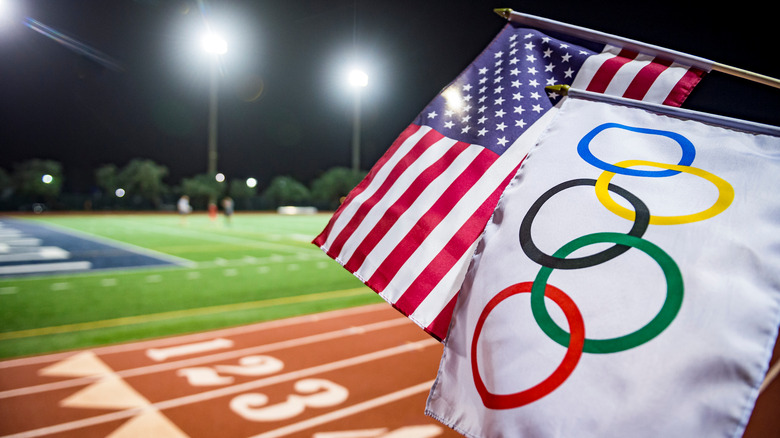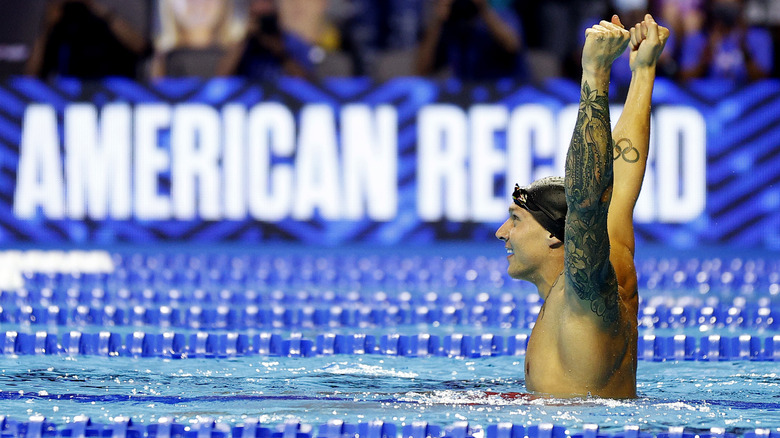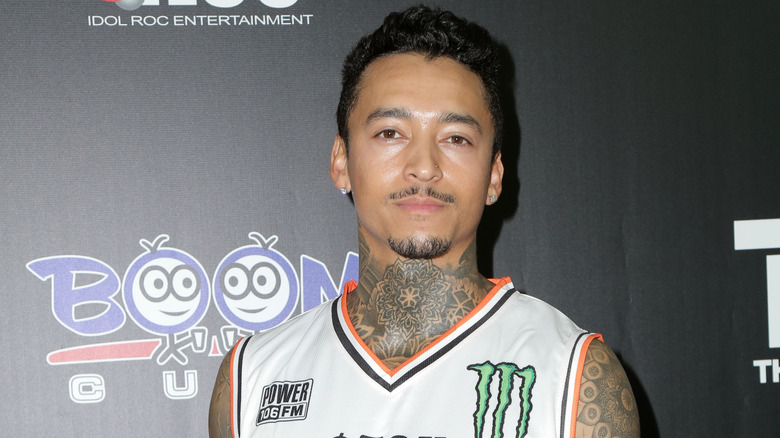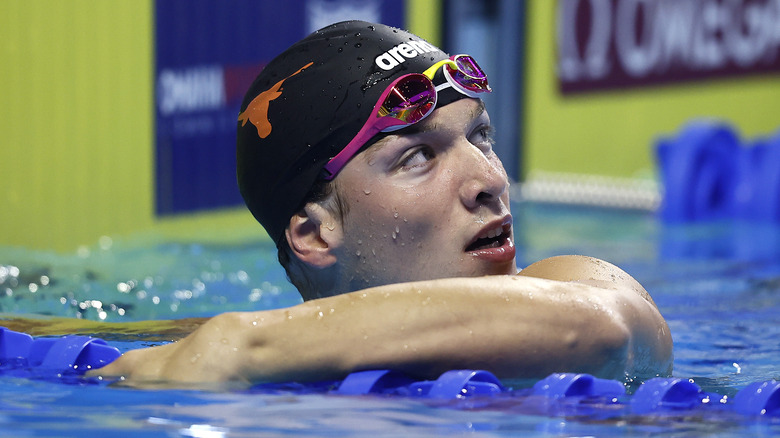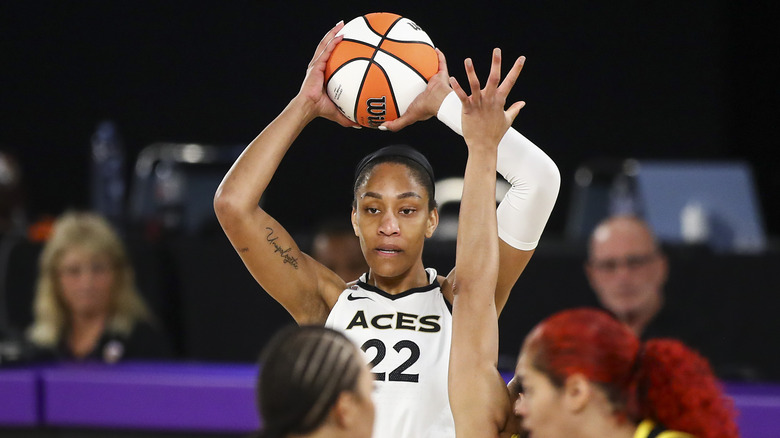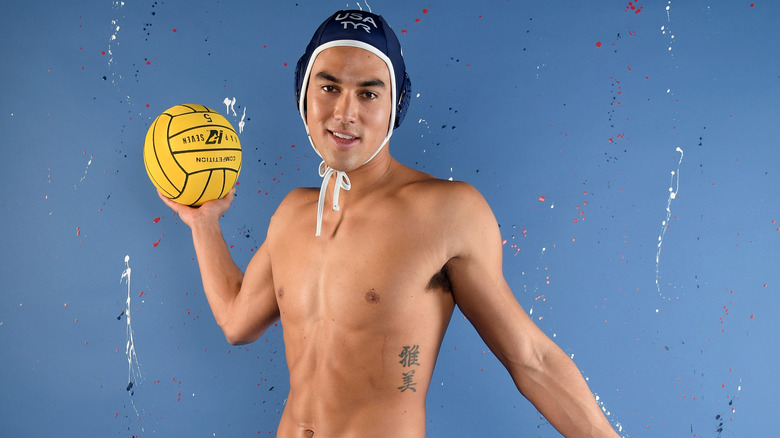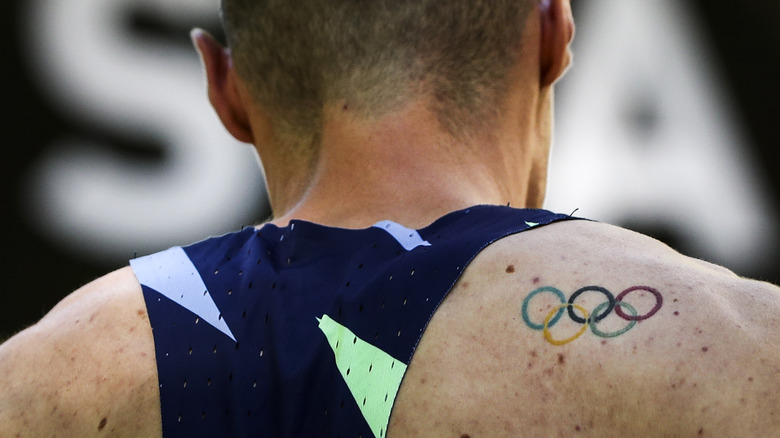Team USA's Tattoos Explained
The 2020 Summer Olympics are gearing up to start in Tokyo in just a few days, a full year after they were delayed by the COVID-19 pandemic. The United States' finest athletes will soon converge upon the Japanese city to compete at the highest levels of their prospective sports.
Many of the athletes, not unlike many members of the general public, sport ink — which is to say, they have tattoos. And as is the case with regular people who are not Olympic athletes, for most of their wearers, their skin art is significant to the people who wear it.
As The Wall Street Journal noted, 613 U.S. athletes will be going to Tokyo. And although it's impossible to say how many of them have tattoos, at least a few do, and are willing to openly discuss them. Further, at least some have tats that will be visible to TV viewers, inasmuch as they won't be covered by the players' uniforms during competition.
Swimmer Caleb Dressel shouts out his home state with his ink
For most Americans who don't live in or near Florida, the state is affiliated with one of two things: either its tourism industry, anchored by Walt Disney World and similar theme parks, or its "Florida man" crime stories that have become memes in the internet age.
Swimmer Caleb Dressel, who according to SwimSwam was born and raised in The Sunshine State, sports ink that tips its hat, so to speak, to his home state. However, it references neither mouse ears nor dumb criminals. Rather, his ink references more important and meaningful aspects of life in the 26th state.
"I have one big one on my arm. It pretty much represents me and my home state of Florida. I have a bear, eagle, and gator in the sleeve as well, which are all native to Florida, as well as some native flowers," he told NBC News. He also has a smaller design on his other arm: the Olympic rings, which need no explanation.
Skateboarder Nyjah Huston is covered in ink
Caleb Dressel, by his own admission, sports two "small" tattoos (actually, one is pretty huge). Skateboarder Nyjah Huston, by comparison, is practically covered in them. What's more, his first tat is tied to his sport.
As he told Inked in 2020, he got his first tattoo at a skateboarding event when he was 18 (and barely legally old enough to get a tattoo in Florida, where he was at the time). Specifically, some of his fellow competitors were getting tats, and they asked him to join in the fun. "At first I was like, 'God, no man, that sounds crazy,'" he said. "Eventually I was like, 'F*** it. I'm down.' And then I went outside and I got it." And here "it" refers to the "Skate and Destroy" phrase, popularized by Thrasher Magazine, on his right forearm.
He would go on to tell NBC News that, at first, his mother wasn't particularly thrilled. But as many a person who has gotten ink will tell you, tattoos can become an addiction, and soon enough, Huston was hooked. Today his original tat is joined by multiple others all over his body.
Drew Kibler says his tattoo empowers him
Another inked swimmer who will be competing in Tokyo this summer is Indiana's Drew Kibler. Unlike his counterpart in the pool, Caleb Dressel, Kibler isn't "out" about his tats. At least one of his tattoos is big and obvious and can be seen easily when he competes — something resembling a bird (perhaps an eagle) or a dragon, on the right side of his abdomen, above his hip, as posted by Swimming World Magazine. Kibler himself won't say much about them. In fact, all that he revealed about his ink, via the Team USA website, is that they're sources of empowerment for him. "They're definitely a source of some mental strength," he said of his tats.
Although it's not clear when, where, or how he got his ink, a 2017 Indianapolis Star article, penned when Kibler was only 16, mentioned a rivalry with another Indiana teen swimming sensation, a lad named Jack Franzman. Though only 17 at the time, and not 18 — the legal age to get a tattoo in Indiana — Franzman sported a tat himself, although his was/is considerably smaller than the one Kibler eventually got.
A'ja Wilson honors her grandmother
WNBA star A'ja Wilson went small, comparatively speaking, when it comes to tats. She appears to have only have two. One is so small that, unless you knew where to look and what to look for, you're unlikely to see it (although it will be visible when she competes, as it's on a part of her body that won't be covered by her uniform). Specifically, she sports a small bit of ink on her left wrist (and a larger one on her right arm).
As she tweeted in 2018, the artwork is her grandmother's signature, calling it "favorite" of her tats, although whether she has more than just the two that are visible is unclear.
Wilson explained to NBC Sports why she got her grandmother's signature permanently inked onto her body. "My grandmother was my number one role model. Her name is Hattie Rakes, and I have her name on my wrist. She passed away in 2016, but she was someone that really helped me believe in myself," she said.
Johnny Hooper's tattoo connects with family
It's something of a joke in the tattoo industry: Westerners getting Asian script tattooed on their skin, often getting a tat that they think means something profound, but usually means something else entirely, or is even gibberish, as Kotaku noted.
Water polo competitor Johnny Hooper, however, didn't make that mistake with his own tattoo. Yes, it's a big, obvious, and visible bit of Asian script that will be seen when he competes, considering that he does his thing in the water and his tat is on his side. However, Hooper is half Asian, according to the Team USA website, fluent in Japanese and holding dual US-Japanese citizenship. He told People that the bit of script is the name of his mother, Mimi, in Japanese.
He also has a second tat, and one that seems out of place on the body of a man whose job involves floating in the water: an anchor, on his ankle. He said that the artwork is a metaphor that has nothing to do with swimming or drowning. "[It] signifies staying grounded and living in the moment."
Multiple US Olympic athletes, and their foreign competition, sport the Olympic rings as a tat
While many of the athletes representing the USA will sport tattoos representing people, objects, places, or other touchstones important to their lives, many others will sport a tat that is specific to the Olympics: that of the Olympic rings themselves. According to NBC News, those bearing that ink include Ryan Lochte, Ryan Murphy, and Chase Kalisz. Also sporting that very tat is runner Clayton Murphy (pictured above). That Olympic athletes and hopefuls would have tattoos of the Olympics rings hardly requires explanation.
The practice of getting that bit of ink is not limited to American athletes, however, although it did start with an American athlete — sort of. As International Business Times explains, back in 1984, American swimmer Chris Jacobs was impressed by a tat on his competitor, Canadian Victor Davis, who sported a maple leaf. Jacobs decided he needed a tat to commemorate his participation in the Olympics, so he went with the rings. Soon, a trend was born, and athletes from all over the world began getting the ink. "Family and friends see the tattoo as special, unique and something for which we should be proud," Jacobs told The Washington Post in 2016.
